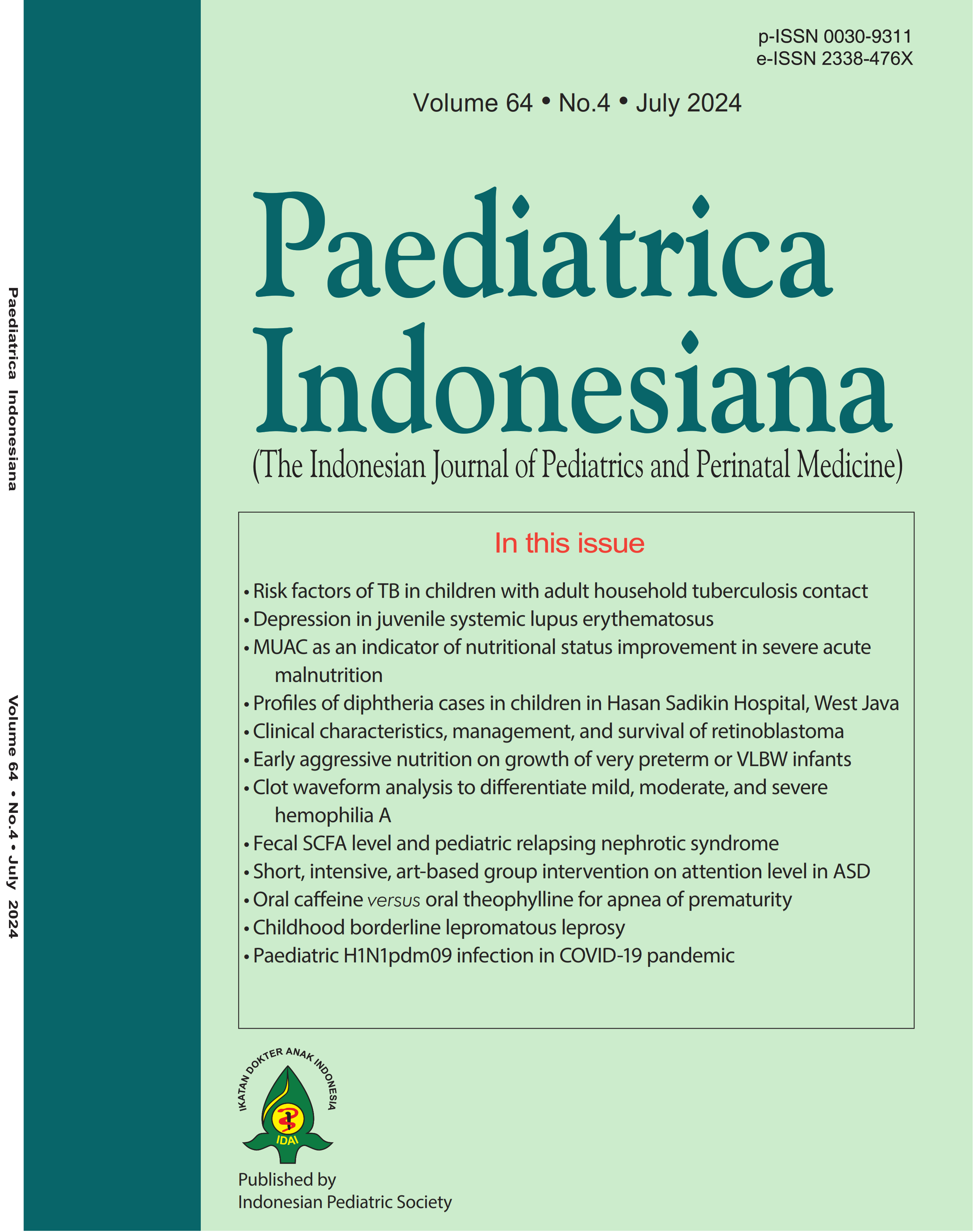Fecal short-chain fatty acids level and pediatric relapsing nephrotic syndrome
Abstract
Background The gut microbiota has a potential role in the development of nephrotic syndrome. Fecal short-chain fatty acid (SCFA) levels are representative of gut microbiota activity.
Objective To assess for potential associations of fecal short-chain fatty acid levels in pediatric relapsing nephrotic syndrome.
Methods This cross-sectional study was done on patients at the Pediatric Nephrology Subdivision of Prof. Dr. R.D. Kandou General Hospital, a referral hospital in Manado, Indonesia. Subjects were 25 patients aged less than 18 years with nephrotic syndrome (NS). We compared the levels of fecal acetic acid, propionic acid, butyric acid percentage, absolute butyric acid, and total short-chain fatty acid between children with relapsing and non-relapsing NS. A receiver operating characteristic (ROC) curve analysis was conducted to determine the significant SCFA cut-off level to diagnose NS.
Results Comparison of fecal SCFAs between relapsing and non-relapsing NS groups showed significantly lower butyric acid percentages, absolute butyric acid level, and total SCFAs levels in the relapsing NS group, but not in acetic acid or propionic acid levels. Further multivariate analysis did not show a significant difference in total SCFA levels between relapsing and non-relapsing NS. Absolute butyric acid level had the strongest association with relapsing NS, with the highest predictive score. The absolute butyric acid cut-off value of 0.85 mg/mL had a high sensitivity (90%) and high specificity (93.3%) for predicting relapsing nephrotic syndrome.
Conclusion Fecal acetic acid, propionic acid, and total short-chain fatty acid in stool are not associated with relapsing NS in children. However, fecal butyric acid measurements are inversely associated with relapsing NS.
References
2. Ley RE, Turnbaugh PJ, Klein S, Gordon JI. Microbial ecology: human gut microbes associated with obesity. Nature. 2006;444:1022–3. DOI: https://doi.org/10.1038/4441022a
3. Valdes AM, Walter J, Segal E, Spector TD. Role of the gut microbiota in nutrition and health. BMJ. 2018;361: k2179. DOI: https://doi.org/10.1136/bmj.k2179
4. Mikusic NLR, Kouyoumdzian NM, Choi MR. Gut microbiota and chronic kidney disease: evidences and mechanisms that mediate a new communication in the gastrointestinal-renal axis. Pflügers Archiv. 2020;472:302–20. DOI: https://doi.org/10.1007/s00424-020-02352-x
5. Roth KS, Amaker BH, Chan JC. Nephrotic syndrome: pathogenesis and management. Pediatr Rev. 2002;23:237–48. DOI: https://doi.org/10.1542/pir.23-7-237
6. Riviere A, Selak M, Lantin D, Leroy F, de Vuyst, L. Bifidobacteria and butyrate-producing colon bacteria: Importance and strategies for their stimulation in the human gut. Front Microbiol. 2016;7:979. DOI: https://doi.org/10.3389/fmicb.2016.00979
7. Tanaka M, Nakayama J. Development of the gut microbiota in infancy and its impact on health in later life. Allergol Int. 2017;66:515–22. DOI: https://doi.org/ 10.1016/j.alit.2017.07.010
8. Sarker MN, Islam MMSU, Saad T, Shoma FN, Sharmin LS, Khan HA, et al. Risk factor for relapse in childhood nephrotic syndrome – a hospital based retrospective study. Faridpur Med Coll J. 2012;7:18-22. DOI: https://doi.org/ 10.3329/fmcj.v7i1.10292
9. Situmorang D, Sekarwana N, Fadlyana E. Risk factor of frequent relapse in pediatric nephrotic syndrome. Am J Med Bio Res. 2016;4:10-12. DOI: https://doi.org/ 10.14238/pi58.5.2018.238-41
10. Trihono P, Alatas H, Tambunan T, Pardede S. Konsensus tata laksana sindrom nefrotik idiopatik pada anak. 2nd ed. Jakarta: BP IDAI; 2012. p.1-20.
11. Rinninella E, Raoul P, Cintoni M, Franceschi F, Miggiano GAD, Gasbarrini A, et al. What is the healthy gut microbiota composition? A changing ecosystem across age, environment, diet, and diseases. Microorganisms. 2019;7:14-24. DOI: https://doi.org/10.3390/microorganisms7010014
12. Tsuji S, Akagawa S, Akagawa Y. Idiopathic nephrotic syndrome in children: role of regulatory T cells and gut microbiota. Pediatr Res. 2021;89:1185–91. DOI: https://doi.org/10.1038/s41390-020-1022-3
13. Zhang J, Luo D, Lin Z, Zhou W, Rao J, Li Y, et al. Dysbiosis of gut microbiota in adult idiopathic membranous nephropathy with nephrotic syndrome. Microb Pathog. 2020;147:104359. DOI: https://doi.org/10.1016/j.micpath.2020.104359
14. Kaneko S, Tsuji S, Kimata T. Role of gut microbiota in idiopathic nephrotic syndrome in children. Med Hypotheses. 2017;108:35–7. DOI: https://doi.org/ 10.1016/j.mehy.2017.07.035
15. Mitsuoka T. Establishment of intestinal bacteriology. Biosci Microbiota Food Health. 2014;33:99–116. DOI: https://doi.org/10.12938/bmfh.33.99
16. Nagpal R, Yamashiro Y. Early-life gut microbial composition. J Pediatr Biochem. 2015;5:41–50. DOI: https://doi.org/10.1055/s-0035-1564573
Copyright (c) 2024 Jeanette Irene Christiene Manoppo, Natharina Yolanda, Adrian Umboh

This work is licensed under a Creative Commons Attribution-NonCommercial-ShareAlike 4.0 International License.
Authors who publish with this journal agree to the following terms:
Authors retain copyright and grant the journal right of first publication with the work simultaneously licensed under a Creative Commons Attribution License that allows others to share the work with an acknowledgement of the work's authorship and initial publication in this journal.
Authors are able to enter into separate, additional contractual arrangements for the non-exclusive distribution of the journal's published version of the work (e.g., post it to an institutional repository or publish it in a book), with an acknowledgement of its initial publication in this journal.
Accepted 2024-09-02
Published 2024-09-02













